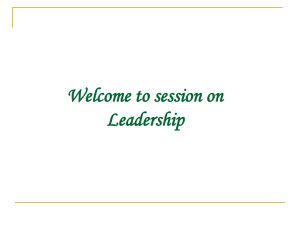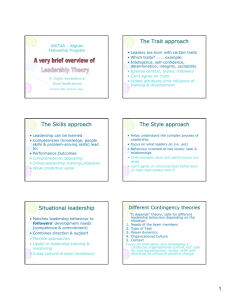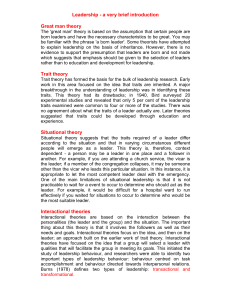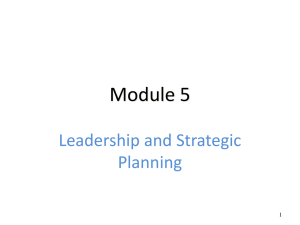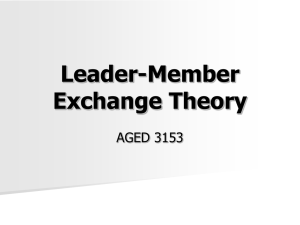File
advertisement
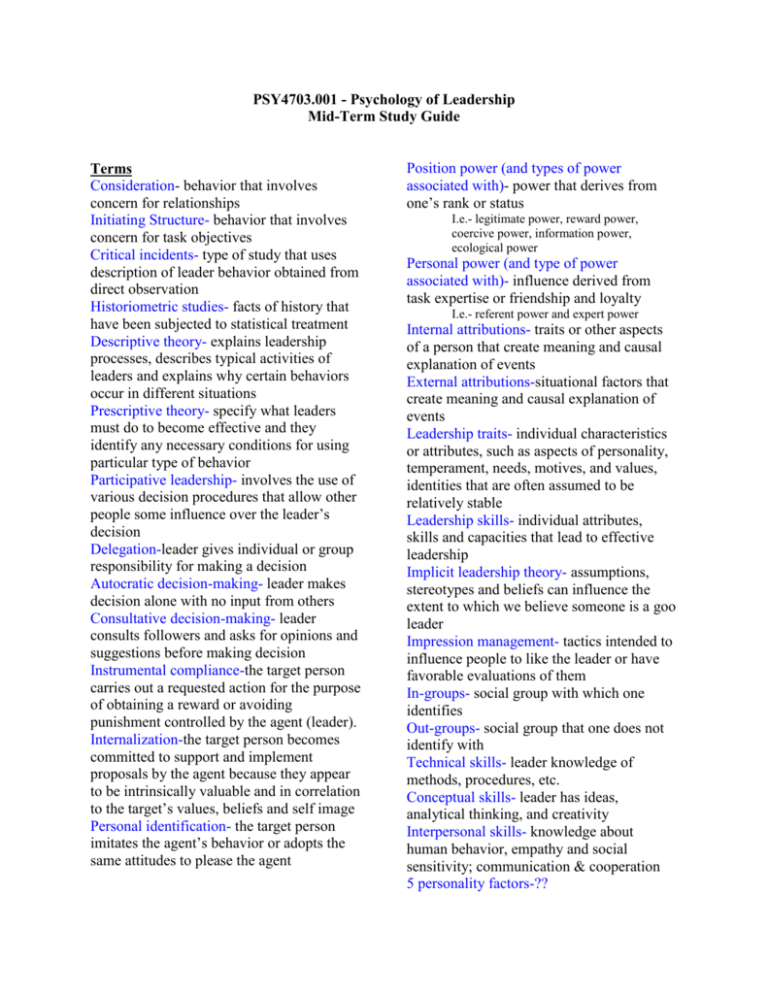
PSY4703.001 - Psychology of Leadership Mid-Term Study Guide Terms Consideration- behavior that involves concern for relationships Initiating Structure- behavior that involves concern for task objectives Critical incidents- type of study that uses description of leader behavior obtained from direct observation Historiometric studies- facts of history that have been subjected to statistical treatment Descriptive theory- explains leadership processes, describes typical activities of leaders and explains why certain behaviors occur in different situations Prescriptive theory- specify what leaders must do to become effective and they identify any necessary conditions for using particular type of behavior Participative leadership- involves the use of various decision procedures that allow other people some influence over the leader’s decision Delegation-leader gives individual or group responsibility for making a decision Autocratic decision-making- leader makes decision alone with no input from others Consultative decision-making- leader consults followers and asks for opinions and suggestions before making decision Instrumental compliance-the target person carries out a requested action for the purpose of obtaining a reward or avoiding punishment controlled by the agent (leader). Internalization-the target person becomes committed to support and implement proposals by the agent because they appear to be intrinsically valuable and in correlation to the target’s values, beliefs and self image Personal identification- the target person imitates the agent’s behavior or adopts the same attitudes to please the agent Position power (and types of power associated with)- power that derives from one’s rank or status I.e.- legitimate power, reward power, coercive power, information power, ecological power Personal power (and type of power associated with)- influence derived from task expertise or friendship and loyalty I.e.- referent power and expert power Internal attributions- traits or other aspects of a person that create meaning and causal explanation of events External attributions-situational factors that create meaning and causal explanation of events Leadership traits- individual characteristics or attributes, such as aspects of personality, temperament, needs, motives, and values, identities that are often assumed to be relatively stable Leadership skills- individual attributes, skills and capacities that lead to effective leadership Implicit leadership theory- assumptions, stereotypes and beliefs can influence the extent to which we believe someone is a goo leader Impression management- tactics intended to influence people to like the leader or have favorable evaluations of them In-groups- social group with which one identifies Out-groups- social group that one does not identify with Technical skills- leader knowledge of methods, procedures, etc. Conceptual skills- leader has ideas, analytical thinking, and creativity Interpersonal skills- knowledge about human behavior, empathy and social sensitivity; communication & cooperation 5 personality factors-?? Need for achievement-enhances leadership effectiveness only if subordinated by a need for socialized power, so that leaders efforts are directed towards building a stronger team Need for power- people with this need enjoy influencing others and tend to seek positions of authority Stress tolerance- essential for leader to remain calm and give decisive direction to subordinates in time of crisis Emotional stability-someone who is welladjusted and not prone to volatile changes in mood; high level of cognitive moral development Leadership substitutes- situational factors that substitute for the role of the leader Subordinate experience, professionalism Satisfying task, intrinsically motivating Group cohesion Role clarity (formalization) Leadership neutralizers-constraints preventing leader form improving deficiencies in intervening variables Subordinate indifference Low position power Inflexible rules, policies Dispersed work sites Idealized influence- behavior that increases follower’s identification with the leader Individualized consideration- providing support, encouragement and coaching to followers Inspirational motivation- communicating an appealing vision and using symbols to focus subordinate effort Intellectual stimulation- behavior that influences followers to view problems from a new perspective and look for more creative solutions Transactional leadership-motivates followers by appealing to their self-interest and exchange benefits Charismatic leadership – form of influence based on follower perceptions that the leader is endowed with exceptional abilities Socialized-followers take pride in being a member of the group and regard membership as most important social identity Personalized- followers imitate leader’s behavior, carry out leader requests and make extra effort to please them Leadership & Other Theories Leader behavior taxonomies1. Task oriented – planning work activities, clarifying goals, monitoring opterations 2. Relations oriented –supporting, developing, recognizing 3. Change oriented- determine need for change, plan for change and implement change Normative Decision Model- model to identify the situations that determine whether a specific type of decision process will be effective Five decision processes a. AI- decide yourself b. AII- get info, then decide alone c. CI-consult individuals, then decide yourself d. CII- consult group, then decide yourself e. GII- group consensus decision acceptance Situational factors o Information (leader, follower) o Likelihood of acceptance o Likelihood of cooperation/conflict o Structure of problem o Disagreement o Importance 67% success rate when used (Vroom & Jago 1988) Limitations o Decisions involve more than one discrete event o Parsimony o Leader knowledge, still not taken into account o Does not take into account relationships Power & Influence - Influence processes and outcome of influence attempts Formal influence often initiated by leader Informal influence often initiated by follower Strategy use influenced by at least 3 factors o Individual characteristics o Goal of subordinate and leader o Characteristics of target influence Instrumental compliance Internalization Personal identification Outcomes o Resistance o Compliance o Commitment Social exchange theory- power is gained through the exchange of benefits or favors between leaders and followers, which can be material or psychological Emphasis on expert power and authority Types of power (Bass, 1960; Etzioni, 1961) Position (formal) power o Legitimate, coercive, ecological, reward and information Personal (referent) power o Expert or referent Leader-member exchange theory- describes the role-making process between a leader and follower (each individual) and the exchange relationship that develops over time. Both leader and subordinate define subordinate’s role. High exchange with select followers Working relationships of dyads Quality of exchange relationship between leader and follower Process approach of transactional approach LMX is not o A universal trait or behavior theory o Not a leader v. follower domain (focus is on both parties ) o Not a contingency theory Focus on how leader relates to follower on daily basis, not in different situations LMX s an active and ongoing process of transactions Value of exchange: o Acknowledge of information o Perceives mutual obligations o Requires mutual communication Dimensions of LMX o Trust o Loyalty o Liking o Support o Attention o Latitude Outcomes of LMX o High quality high performance, job satisfaction, organizational commitment, intention to stay Focus on longitudinal studies, not statistical LMX positives o Emphasizes differential o Stresses importance of relationships communication o Analyzes the quality of dyads o Suggests high quality o Focus on active transactions positive outcomes LMX negatives o Lacks clear definition o Fails to address equity o Unclear how process evolves perceptions o Need more longitudinal o Unclear level of analysis studies to understand how relationships vary Affective Events Theory- model developed to explain how emotions and moods influence job performance and satisfaction Ability-based model of Emotional intelligence (Mayer, Salovey & Caruso)- based model of emotional intelligence: Emotional intelligence involves the ability to perceive, appraise and express emotion; the ability to access and generate feelings when they facilitate thought; ability to understand emotion and emotional knowledge; and the ability to regulate emotions to promote emotional and intellectual growth o Participation and identification o Facilitation of thought o Understanding o Emotion management And individual needs to understand their emotions and emotions of others as well as regulate these emotions by directing them towards constructive activities and personal performance Fiedler’s LPC contingency model- “Least-Preferred Coworker” High LPC rate LPC favorably and means leader cares more about relationships than task objectives; values interpersonal success Low LPCrates LBC negatively and means leader care more about task achievement over interpersonal success Not as strong of a theory as others** Path-Goal Theory-focuses on exchange; leader behavior can influence subordinate satisfaction and performance by increasing pay-offs or outcomes for work accomplished and by making sure there is a clear path for getting work done (goal) by removing obstacles and providing resources Key facets o Leader behaviors: supportive, directive, participative, achievement oriented o Situational variables: task (stressful, boring, dangerous, etc.), subordinate (experience, competence) Cognitive Resources theory- idea that when stress is low, leaders are able to take advantage of cognitive resources and use them well, but when stress is high, leaders tend to rely more on experience and less on intellect. Thus intelligence shows a smaller influence on performance during crisis or high stress. Leaders revert to what has been learned Leader Substitutes theory- aspects of a situation that make task-oriented behavior or relations oriented behavior by the designated leader redundant or ineffective. Such as: Subordinate experience, professionalism Satisfying tasks, intrinsically motivating Group cohesion Role clarity (formalization) Transformational Leadership- leader behaviors drive key follower reactions trust, satisfaction, identification, fairness, efficacy, etc. Idealized influence- setting a good example Intellectual stimulation- encourage followers to think outside the box Multiple choice and Short Answer Possibilities What differentiates effective from ineffective leadership? o An effective leader is a good listener, open to other’s ideas, organized, leads by example, sets goals and is considerate. Where as an ineffective leader is dictatorial or lasses-faire, emotionally volatile, lacks knowledge, is disorganized, tries to be a “friend” to employees. Effectiveness is measure by the extent to which leader’s organizational unit performs successfully and attains goals. What are some examples of multiple levels of leadership? o o o o Intra-individual leadership Researchers use psychological theories of personality traits, values skills, motivations and cognition to explain the decisions and behavior of individual leader. Rare to describe only the leader** Dyadic process Focus is on relationship between leader and subordinate or follower. Satisfies need to influence (LMX theory is a dyadic leadership theory) Group process Focus is on the influence of leaders on collective processes that determine team performance Organizational process Group provides a better understanding of leadership effectiveness. Describes leadership as a process that occurs in a larger “open system” in which groups are subsystem. What is common method bias? o Measures are affected by correlations among them being inflated or deflated depending upon several different factors Describe two similarities and two differences between managers and leaders o Managers- deal with every day supervision, where as leaders focus on long term goals and planning o Managers are in charge of everyday support and direction of followers, where as leaders are in charge of large recognition What are some outcomes of leadership researchers have looked at? Drawing on Yukl’s taxonomy of leadership behavior, describe some task-related behaviors, relations behaviors, and change behaviors o o o What are four differences between a laboratory experiment and a field study o o Task oriented- supervisors Planning work activities Clarifying roles and objectives Monitoring operations Relations behaviors- mid level managers Supporting Developing Recognizing Change behaviors- senior leaders Determine need for change Plan for change Implement change Monitor progress Lab study is a controlled environment Field study can look at an actual organization o o Lab study has problem with external validity Hard to define leadership in field study Leadership research methods – define each and know pros/cons o o o o o Survey research Advantages: easy, real data, can study wide range of topics, easy to communicate results, multiple levels of data Disadvantages: biases and error, ambiguous times, method, source bias, design limitations Critical incidents – “field experiments” Advantages: focus on effectiveness of behavior, rich and detailed data, large N-size in done via a questionnaire, good exploratory technique to reveal strengths and weaknesses Disadvantages: assumes knowledge of “effective” leadership behavior, selective remembering and reporting based on implicit ideas about good/bad leadership, miss everyday behavior, limited focus leader behavior Interviews, observation Advantages: actual organizational behavior, chance for follow-up to gain details or insight, people like to talk about their jobs. Disadvantages: time consuming, relies on qualitative interpretation (content coding an help), accuracy and representation of what is observed, low N-size Case studies/qualitative research Advantages: complex, rich descriptive data, contextual information captured, multiple perspectives and organizational levels included, can cover a range of topics. Disadvantages: difficult to quantify and empirically examine results, comparison to other leaders, org data is difficult, limited generalizability, need solid theory; often lacking, often limited to descriptive findings Historiometic o o Advantages: high accessible, descriptive and prescriptive, known outcomes, can cover many topics Disadvantages: need solid theory, time consuming, requires careful sampling and material selection Lab experiments Advantages: control over variables of interest, can infer causality, can cover many topics, can collect and analyze data at multiple levels of leadership Disadvantages: more resource intensive than surveys, cant always manipulate topic of interest, generalizability; fidelity of setting, student samples criticized, immediate relevance, sometimes hard to sell Quasi experiments Advantages: control over some variables of interest, can infer causality, can conduct in organizations, can collect and analyze data at multiple levels of leadership, relevance is apparent Disadvantages: no random assignment, requires more complex design and N-size to infer causality, more resource intensive than surveys, cant always manipulate topic of interest, limited purpose, typically to test an intervention 6 Situational variables influencing type of decision making process (e.g., autocratic, consultative, group consensus) to influence decision acceptance and quality 1. Information (leader, 4. Disagreement followers) 5. Structure of problem 2. Likelihood of acceptance 6. Importance 3. Likelihood of cooperation/ conflict Conditions likely to result in more successful delegation o Responsibilities are specified o Monitor progress in clearly appropriate ways o Adequate authority and o Arrange for subordinate to specific limits of discretion have access to necessary are given information o Reporting requirements are o Provide assistance and specified support, but do not reverse o Ensure subordinate accepts delegate responsibilities o Make mistakes a learning o Inform others who need to experience know Influence tactics – know specific names and be able to give examples o o o o o o Rational persuasion Use logical arguments, evidence to gain support Apprising Point out personal or professional benefits of providing support Inspirational appeals Appeals to values, ideals, emotions to gain support Consultation Encourage input and participation to gain support Exchange Offer explicit incentives for support Collaboration o o o o o Provide resources, assistance for support Personal appeals Ask for support as a personal favor Ingratiation Use praise, flattery before asking for support Legitimating Use rules, policies, contracts to back up request for support Pressure Use demands, threats, frequent reminders to gain support Coalition Leverage existing support of others to gain support What do leaders contribute to high quality exchange relationships? o Leaders do more for the follower, improves their self-worth, more trust, influence, information, challenging work and communicate more frequently What do followers contribute to high quality exchange relationships? o Follower goes beyond formal role requirements, has satisfying performance, is loyal and committed t the leader Define and describe 6 dimensions of LMX relationships 1. Trust- abstract 4. Latitude- concrete 2. Liking- abstract 5. Attention -concrete 3. Loyalty- abstract 6. Support -concrete Problems with LMX measures o o o Lack of validity Different dimensions for correlated items Combine relationship quality and exchange commodity o o o o Lack of agreement between leaders and member Unclear level of analysis Overreliance on questionnaires Lack of attention to equity perceptions o o o o Lack of longitudinal studies Difference between leader traits and skills o A trait refers to person’s individual attributes, including aspects of personality, temperament, needs motives and values. Skills refer to a leader’s ability to do something in an effective manner. Competencies are a combination of traits and skills Describe how some traits facilitate effective leadership and how some traits can derail leadership (bright and dark traits). In what ways or under what circumstances can bright traits be bad and dark traits be good? o If self-confidence occurs in excess, dysfunctional behaviors occur Leaders become overly optimistic and make risky decisions that don’t always pay off Sometimes can be come arrogant or know-it-all with makes it difficult to cooperate with others and form/grow relationships o Need for power Must be socialized need for power if going to be beneficial. If it is a personalized need for power, leader will dominate subordinates, keeping them weak and dependent 3 approaches to studying emotions in leadership contexts o Surveys o Experimental studies o Qualitative studies Needs for future research on emotions and leadership o Lack of attention to group dynamic Emphasize attributions and behaviors Leadership research defines emotion variables in ways that are consistent with broader emotion literature Theory development still weak, over emphasis on benefits of positive emotion o o o o Balance of lab and field studies Field studies poorly aligned with theory Measurement diversity and soundness lacking Multiple levels need more consideration Does leadership research need to continue to explore the role of emotional intelligence? Why or why not? o Yes, because research that concludes there is not a emotional intelligenceleadership like is flawed. What skills are needed by leaders occupying lower-level vs. senior/executive level leadership positions? o Lower-level managers need successful problem solving, and technical achievement, where as higher level leaders need to delegate and not micromanage subordinates who have more expertise about the nitty-gritty details In what ways can a situation be favorable for a leader based on LPC theory? o Can be favorable when leader has substantial position power, the task is highly structured and relations with subordinates are good What are intervening variables in House’s Path-Goal Theory? o Intrinsic valence of behavior o Expectancy that effort leads to accomplishment o Intrinsic value of goal accomplishment o Expectancy that goal accomplishment leads to desired rewards o Valence of reward to followers Compare and contrast the mental models for two of the three types of outstanding leadership types o Transformational leadership: leaders behaviors drive key follower’s reactions such as: trust, satisfaction, identification, fairness and efficacy o Transactional leadership: follower offered a contingent award o Transactional did better in certain criteria Job satisfaction, motivation, leader job performance o Transformational did better in others Increased domain specific knowledge Decreased working memory load due to knowledge compilation More automatic processing More meta-cognition and meta-management Principle-based view of problems What four factors should be incorporated into theories of leader cognition? o o o o Satisfaction with leaders, group/organization performance, rated leader effectiveness What are the benefits of experience for leaders? How does experience contribute to knowledge and skill development? o Experience enables: Knowledge (forms of, organization, richness) Processing operations – Sometimes problems require a leader to define the problems and generate new ideas and solutions; other times they require careful evaluation of a limited set of existing alternatives that might be the inly options given the situation. Leaders may need both types of processes. Strategies for applying processes (standards, using single v. multiple processes) Things the leader can do to more effectively apply the processing operations. For example, setting standards- if a solution doesn’t meet a certain standard, the leader generates alternatives or applies multiple processes Errors (biases, focus on simple causes or short term feedback) Leaders may be prone to various error or biases in their problem solving and decisionmaking, such as using heuristics or rules of thumb when the situation calls for something different; focusing on short term outcomes What situational factors require greater levels of leader cognition? o Situation is complex and ambiguous- makes it harder to identify critical cause in the situation and harder to predict outcome success o Different options or courses of action are available o Novel issues- leader cannot apply existing solutions, must generate new ones, no scripts in place to deal with existing situation o Access to cognitive resources- stress can interfere with access to and use of cognitive resources such as intelligence Having less overall cognitive capacity can mean less cognitive resources to draw from; time pressure can limit access to resource and role demands or divided attention due to so many competing leadership tasks o Social and structural support from followers- social support may ease stress for leaders while structural support such as providing a leader with ideas and help can add to cognitive recources available

